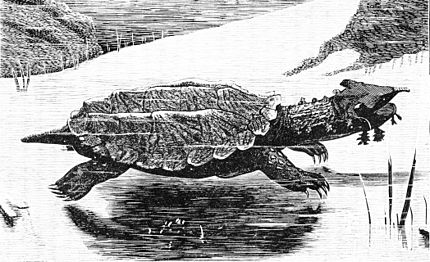Popular Science Monthly/Volume 16/March 1880/The Matamata
| THE MATAMATA. |
By E. SAUVAGE.
PIERRE BARRÈRE, in an essay on the natural history of the equatorial possessions of France, written in 1741, described a tortoise of a singular form which the Indians of Guiana called the raparara. It had, he said, a long, wrinkled neck, from which hung small membranes, ragged or slashed like a fringe; its head was flattened and triangular, and ended in a kind of trunk shaped like a quill-pen; and the upper part of the shell was furrowed and marked "with large knobs. This concise description gives a fair idea of the principal features of the tortoise which is illustrated in the cut. It is hard to tell which most attracts attention, the large, triangular, depressed head,

The Matamata (Chelys matamata).
the mouth extending behind the ears, or the doubly furrowed back with its three knobbed ridges. The head ends in a small, movable snout; the eyes are very small and set far forward; the sharp jaws are covered with a horny sheath. The neck is thick and bristles with tubercles, and from each side of it hang the ragged membranes which float in the water. The scales of the carapace are raised into prominent knobs, and from the tip of each knob furrows radiate in every direction. The tail is short and obtuse. The long and hooked claws are attached to paws which are somewhat palmated and of moderate length. The carapace is beveled to give play to the hinder limbs, and the cuirass is narrow and hollowed by a deep furrow in its after part. The upper part of the body is for the most part of a brick-red; the cuirass, not so deeply colored, is marked by blackish marblings. According to M. Spix, who has observed the living animal, the scales of the carapace are of a maroon brown, with radiating streaks, and the lower part of the head and the most of the members are of a greenish yellow pricked with brown. This tortoise is a native of the Guianas, and lives in stagnant waters and half-dried marshes. Except at the time of laying its eggs, it hardly ever goes to the land. Immersed in the mud, which it is not unlike in color, it lies in wait for the creatures which are imprudent enough to swim near it. The ragged membranes, floating in the water like worms, attract fish seeking for food. When a suitable prey passes within reach, the head which has been bent to one side instantly darts out as if it were hurled by a spring, and the victim is quickly buried in the huge throat of the reptile.
This tortoise, described by Barrère as the raparara, has been called by Schneider the Sinibrian tortoise. Bruguibre, in his "Journal d'Histoire Naturel de Paris," has given it the name of matamata, which is generally accepted by modern zoölogists. The only species from which the genus Chelys has been formed lives in the Guianas; and the individual, which is now to be seen in a living state in the museum at Paris, was captured there by the French explorer, M. J. Crevaux.